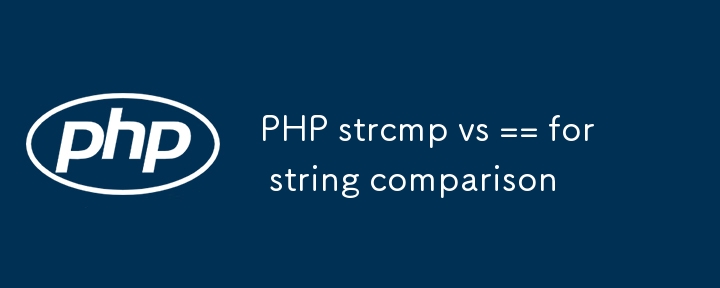To compare PHP strings, you should choose different methods according to your needs, and you cannot blindly use ==. Strictly compare it with ===, and strcmp() is used for dictionary order comparison. 1. == is unreliable, and will perform type conversion, resulting in unexpected results, such as '0e123' == '0' is true; 2. === is the safest comparison method, and the judgment is completely consistent and the type is not converted; 3. strcmp() is used to compare strings in dictionary order, returning -1, 0, and 1 to represent size relationships, and is case sensitive; 4. Safe scenarios must avoid ==, and === is better in performance. Pay special attention to traps when comparing null or boolean values.

When comparing strings in PHP, many people are confused about using strcmp() function or the == operator. In fact, the behaviors of the two are not exactly the same, and there are differences in usage scenarios.

To put it directly into the point: If you are going to do a strict string comparison, you should prioritize other methods rather than == . And strcmp() has its scope of application, but it is not omnipotent.
1. == is not a real "string comparison"
You may think that writing 'abc' == 'abc' is a string comparison, but in some cases, PHP's == will do something unexpected.

For example:
'0e123' == '0' // Return true
This is because in loose comparisons, PHP tries to convert strings to numbers. If both sides look like scientific notation (such as starting with 0e ), they are treated as floating point numbers, and the result is 0 == 0 .

So, when you want to compare if two strings are literally the same , == is not reliable.
2. === is a safer alternative
If you just want to determine whether the two strings are exactly the same (including case, character order, length, etc.), you should use === , which will not perform type conversion.
for example:
'abc' === 'abc' // true '0e123' === '0' // false
This comparison method is more intuitive and easier to understand than strcmp() . Especially when verifying user input or sensitive data (such as password hash), it is necessary to use strict comparison.
3. The purpose of strcmp() : sorting and case sensitivity
So what does strcmp() do? It is mainly used to compare strings in dictionary order , returning an integer value to represent the size relationship between two strings:
- Return value < 0: The first string is smaller than the second
- Return value = 0: Two strings are equal
- Return value > 0: The first string is greater than the second
For example:
strcmp('apple', 'banana') // -1 strcmp('hello', 'hello') // 0
This function is useful when sorting, searching, or when you need to know the order of strings. And it is case sensitive, that is, 'Apple' and 'apple' will be considered different.
There is also a case-insensitive version that is strcasecmp() , which can be selected as needed.
4. Small details on safety and performance
- Security : Do not use
==to compare password hash or tokens, because you may encounter magic hash problems, resulting in wrong matches. - Performance :
===is usually faster thanstrcmp()because it does not require calculating the string order, it only needs to determine whether it is completely consistent. - Note the null trap :
==can produce strange results if one of the operands isnullor boolean. For example,'abc' == nullistrue, but'abc' === nullis a reasonable judgment.
Basically that's it. You can decide which method to use according to actual needs:
- Decision is exactly consistent →
=== - Requires dictionary order →
strcmp() - Comparison of case-insensitive order →
strcasecmp() - Never use it in sensitive occasions
==
The above is the detailed content of PHP strcmp vs == for string comparison. For more information, please follow other related articles on the PHP Chinese website!

Hot AI Tools

Undress AI Tool
Undress images for free

Undresser.AI Undress
AI-powered app for creating realistic nude photos

AI Clothes Remover
Online AI tool for removing clothes from photos.

Clothoff.io
AI clothes remover

Video Face Swap
Swap faces in any video effortlessly with our completely free AI face swap tool!

Hot Article

Hot Tools

Notepad++7.3.1
Easy-to-use and free code editor

SublimeText3 Chinese version
Chinese version, very easy to use

Zend Studio 13.0.1
Powerful PHP integrated development environment

Dreamweaver CS6
Visual web development tools

SublimeText3 Mac version
God-level code editing software (SublimeText3)

Hot Topics
 What are some best practices for versioning a PHP-based API?
Jun 14, 2025 am 12:27 AM
What are some best practices for versioning a PHP-based API?
Jun 14, 2025 am 12:27 AM
ToversionaPHP-basedAPIeffectively,useURL-basedversioningforclarityandeaseofrouting,separateversionedcodetoavoidconflicts,deprecateoldversionswithclearcommunication,andconsidercustomheadersonlywhennecessary.StartbyplacingtheversionintheURL(e.g.,/api/v
 How do I implement authentication and authorization in PHP?
Jun 20, 2025 am 01:03 AM
How do I implement authentication and authorization in PHP?
Jun 20, 2025 am 01:03 AM
TosecurelyhandleauthenticationandauthorizationinPHP,followthesesteps:1.Alwayshashpasswordswithpassword_hash()andverifyusingpassword_verify(),usepreparedstatementstopreventSQLinjection,andstoreuserdatain$_SESSIONafterlogin.2.Implementrole-basedaccessc
 What are the differences between procedural and object-oriented programming paradigms in PHP?
Jun 14, 2025 am 12:25 AM
What are the differences between procedural and object-oriented programming paradigms in PHP?
Jun 14, 2025 am 12:25 AM
Proceduralandobject-orientedprogramming(OOP)inPHPdiffersignificantlyinstructure,reusability,anddatahandling.1.Proceduralprogrammingusesfunctionsorganizedsequentially,suitableforsmallscripts.2.OOPorganizescodeintoclassesandobjects,modelingreal-worlden
 What are weak references (WeakMap) in PHP, and when might they be useful?
Jun 14, 2025 am 12:25 AM
What are weak references (WeakMap) in PHP, and when might they be useful?
Jun 14, 2025 am 12:25 AM
PHPdoesnothaveabuilt-inWeakMapbutoffersWeakReferenceforsimilarfunctionality.1.WeakReferenceallowsholdingreferenceswithoutpreventinggarbagecollection.2.Itisusefulforcaching,eventlisteners,andmetadatawithoutaffectingobjectlifecycles.3.YoucansimulateaWe
 How can you handle file uploads securely in PHP?
Jun 19, 2025 am 01:05 AM
How can you handle file uploads securely in PHP?
Jun 19, 2025 am 01:05 AM
To safely handle file uploads in PHP, the core is to verify file types, rename files, and restrict permissions. 1. Use finfo_file() to check the real MIME type, and only specific types such as image/jpeg are allowed; 2. Use uniqid() to generate random file names and store them in non-Web root directory; 3. Limit file size through php.ini and HTML forms, and set directory permissions to 0755; 4. Use ClamAV to scan malware to enhance security. These steps effectively prevent security vulnerabilities and ensure that the file upload process is safe and reliable.
 What are the differences between == (loose comparison) and === (strict comparison) in PHP?
Jun 19, 2025 am 01:07 AM
What are the differences between == (loose comparison) and === (strict comparison) in PHP?
Jun 19, 2025 am 01:07 AM
In PHP, the main difference between == and == is the strictness of type checking. ==Type conversion will be performed before comparison, for example, 5=="5" returns true, and ===Request that the value and type are the same before true will be returned, for example, 5==="5" returns false. In usage scenarios, === is more secure and should be used first, and == is only used when type conversion is required.
 How can you interact with NoSQL databases (e.g., MongoDB, Redis) from PHP?
Jun 19, 2025 am 01:07 AM
How can you interact with NoSQL databases (e.g., MongoDB, Redis) from PHP?
Jun 19, 2025 am 01:07 AM
Yes, PHP can interact with NoSQL databases like MongoDB and Redis through specific extensions or libraries. First, use the MongoDBPHP driver (installed through PECL or Composer) to create client instances and operate databases and collections, supporting insertion, query, aggregation and other operations; second, use the Predis library or phpredis extension to connect to Redis, perform key-value settings and acquisitions, and recommend phpredis for high-performance scenarios, while Predis is convenient for rapid deployment; both are suitable for production environments and are well-documented.
 How do I perform arithmetic operations in PHP ( , -, *, /, %)?
Jun 19, 2025 pm 05:13 PM
How do I perform arithmetic operations in PHP ( , -, *, /, %)?
Jun 19, 2025 pm 05:13 PM
The methods of using basic mathematical operations in PHP are as follows: 1. Addition signs support integers and floating-point numbers, and can also be used for variables. String numbers will be automatically converted but not recommended to dependencies; 2. Subtraction signs use - signs, variables are the same, and type conversion is also applicable; 3. Multiplication signs use * signs, which are suitable for numbers and similar strings; 4. Division uses / signs, which need to avoid dividing by zero, and note that the result may be floating-point numbers; 5. Taking the modulus signs can be used to judge odd and even numbers, and when processing negative numbers, the remainder signs are consistent with the dividend. The key to using these operators correctly is to ensure that the data types are clear and the boundary situation is handled well.






